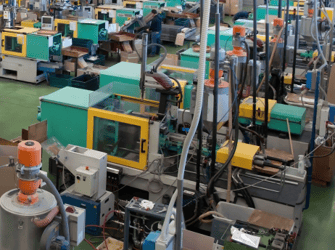A good purging program requires defining the amount of purging compound to be used on the floor for each case and machine. So a common question from process engineers is "How do I calculate how much purging compound I put into the machine? Based on tonnage or spindle diameter?" There are average purge amounts based on machine size according to supplier recommendations. However, this does not always take into account all the factors that directly influence the amount that is ultimately needed to complete the cleaning. Examples of these factors may be: the presence of carbon contamination, process temperatures, type and grade of resin, additives, colorants; and specific characteristics of screw, barrel, mold and machine type. For example, for a mechanical purge that cleans mechanically, it requires an average of 1 to 3 barrel capacities; this could be communicated to the user. Consider that this average is an estimate and is not based on a previous case-specific result on each machine.
How do you confirm the effect of the purge related to the amount fed into the machine?
The answer is: with an initial test monitored using the recommended purging procedure of the product they are evaluating, and not with traditional purging practices. In order to initiate the test where the cleaning performance is to be checked, it is critical to first consult with the manufacturer of the purging procedure. Confirmation of the procedure helps to avoid uncertainty and reaching inaccurate conclusions with doubts such as: "and if the procedure had been the right one, it would have worked"; because it is very common to find tests and results where there were deviations; either because of a bad procedure, using entrenched practices or different providers.
The manner of measuring the amounts of material coming out of the machine is another critical factor. At the beginning of the purging process, when material comes out of the machine, the normal thing is that the remaining resin that is being purged comes out first, and then little by little the purging compound starts coming out. Due to the need to measure the purging compound coming out of the machine (and not the resin), it is necessary to separate the resin pile from the purging compound pile at the best possible point. Whoever is running the test is responsible for observing when the material coming out of the machine changes. Sometimes it is better that someone else be assigned to watch for this, while the person who is running the machine stays in front of the screen and controls. When the purging process ends and the compound starts coming out with a clean appearance; only that amount of purging compound is weighed; and the amount remaining in the machine is not included. You can already assume that the next time you run the purging process, you will use the amount you weighed and no more than that.
The procedure and ways of measuring and weighing the materials are critical steps in optimizing the consumption of purging compound after the initial test. The initial test should define the performance of the purging process and its cost benefit when compared to another method. So, in the comparison of methods, you need to consider: the percentage of scrap; the purging time and the amount of purging compound to be fed to the machine the next time.
Learn more about how to reduce production downtime and protect your profits with a purging compound.







Comments